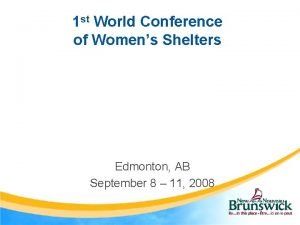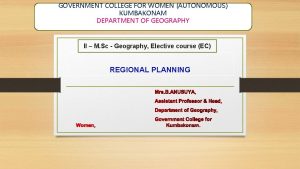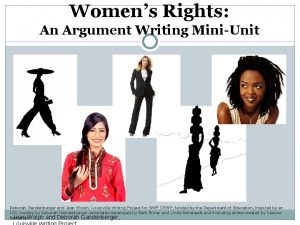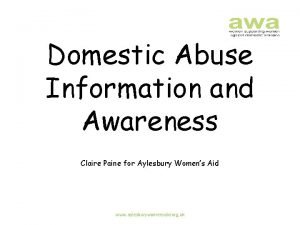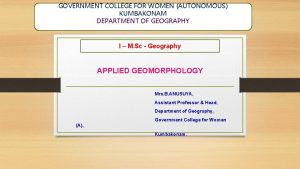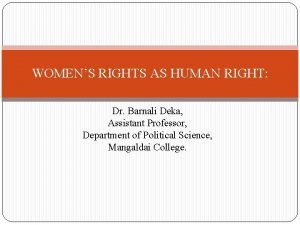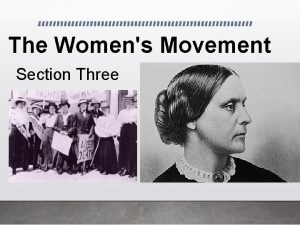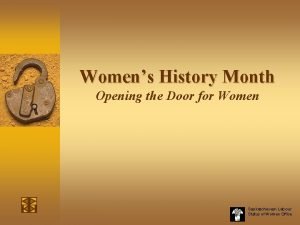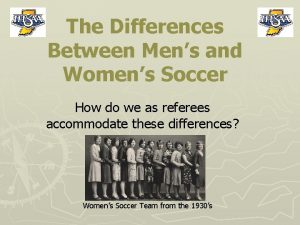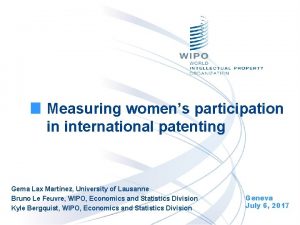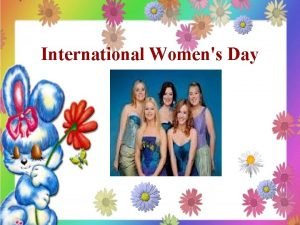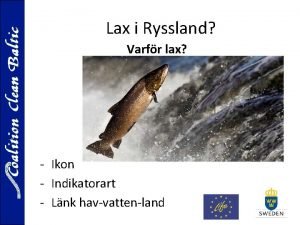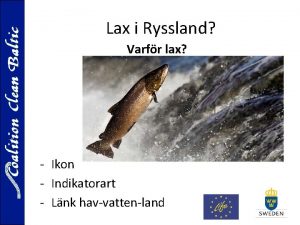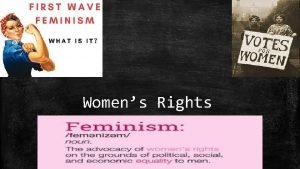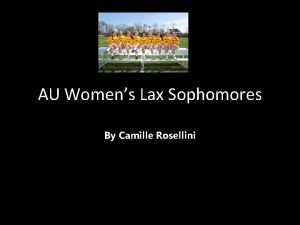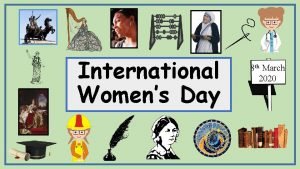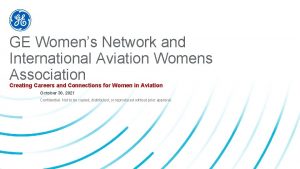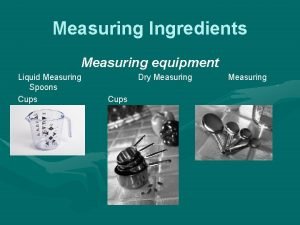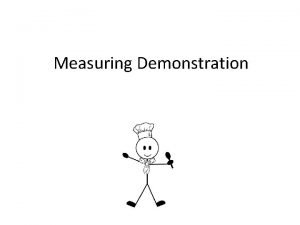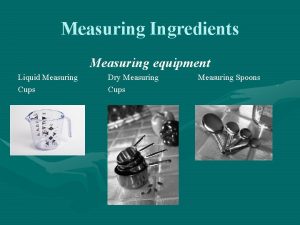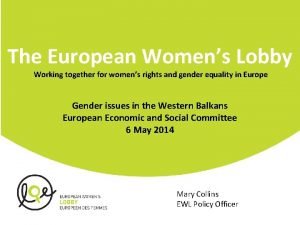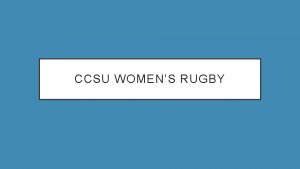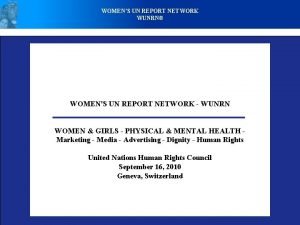Measuring womens participation in international patenting Gema Lax



























- Slides: 27

Measuring women’s participation in international patenting Gema Lax Martínez, University of Lausanne Bruno Le Feuvre, WIPO, Economics and Statistics Division Kyle Bergquist, WIPO, Economics and Statistics Division Geneva July 6, 2017

2 Outline Part I - Research & methodology Part II - Statistical results Part III - Further Research

3 PART I RESEARCH & METHODOLOGY Gema Lax Martínez, University of Lausanne

4 Gender Research

Why it matters? Women contribute to all fields of creativity, yet they remain underrepresented, including in advanced economies. “Leaky pipeline”: Gender inequality is increasingly worse along a researcher career Lack of encouragement and lower position in the hierarchy explain any productivity gap While women patent less, the quality and impact of their patents are equal or better All studies pointed to the need for more data broken down by gender. 5

What can be done? Direct: Self-declaration + Captures information directly at source – Cannot be applied retroactively Indirect: Attribution based on secondary source + Can be as reliable as primary – Difficult to collect in multiple countries and years Indirect: Attribution based on name gender semantics + Can be applied retroactively – Difficult for languages without clear-cut rules. Indirect: Attribution based on name-gender dictionary + Can be applied retroactively – Depends heavily on the dictionary coverage 6

What have we done? 7 World Gender-Name Dictionary Consolidated 14 different sources Extended for 12 languages Contains 6. 2 million names for 182 different countries

8 What have we done? We applied the WGND to the patent applications filed through the Patent Cooperation Treaty (PCT) System: Inventors and individual applicants 9 millions Gender attribution 96. 1% Gender attribution by country of residence

World Intellectual Property Indicators 2016 edition Special theme Measuring women’s participation in international patenting

PART II STATISTICAL RESULTS Bruno Le Feuvre, WIPO, Economics and Statistics Division

PCT Yearly Review, 2017 edition Gender Mainstreaming Statistics on women inventors have become part of the regular reporting on the PCT System

Share and number of PCT applications with women inventors

Share of PCT applications with women inventors for the top 20 origins, 2016

Share for selected fields of technology

PCT applications with women inventors by institutional sector

When will we achieve gender balance?

17 PART III FURTHER RESEARCH Kyle Bergquist, WIPO, Economics and Statistics Division

New developments Identify gender in Hague and Madrid Systems statistics Increase sources of World Gender-Name Dictionary Refine gender indicators Link to different data sources

Global innovation index, 2017 edition Identified and ranked global clusters via inventors’ geolocation Shows the share of women inventors for the top 100 clusters in the world For example 31. 3% of PCT applications filed in Beijing had women inventors

All listed inventors Seoul San Josean Francisco Tokyo-Yokohama Shenzen. Hong Kong (China)

All listed female inventors

Share of female inventors to all inventors Seoul 27. 5% San Josean Francisco 15. 0% Tokyo-Yokohama 8. 5% Shenzhen-Hong Kong (China) 28. 9%

All inventors: Northeast US Boston-Cambridge, MA Hartford, CT Chicago, IL Cleveland, OH New York, NY Philadelphia, PA Cincinnati, OH Washington DC

Share of female inventors: Northeast US Boston-Cambridge 17. 4% Hartford 9. 7% Chicago 13. 1% Cleveland 11. 2% Philadelphia 19. 6 Cincinnati 14. 6% Washington DC 19. 4% New York 20. 0%

Top technology sector: Northeast US Boston-Cambridge, MA Hartford, CT Chicago, IL Cleveland, OH New York, NY Philadelphia, PA Cincinnati, OH Washington DC

Conclusion The World Gender-Name Dictionary is a valuable contribution to gender studies in multiple areas of research Gender participation in the IP system is getting better. Progress is observed in most countries, in all technical fields and in both academic institutions and companies However, it remains far from balanced and women participation in patenting is not equally distributed across countries, technologies and sectors Possible extensions to statistics of the Madrid and Hague systems & other research (see part III)

Thank you! Questions?
 Gemalax
Gemalax Cardinality ratio constraint
Cardinality ratio constraint Womens shelter edmonton
Womens shelter edmonton Late night womens hour
Late night womens hour Ballybeen womens centre
Ballybeen womens centre Womens college kumbakonam
Womens college kumbakonam Women's rights
Women's rights Aylesbury womens aid
Aylesbury womens aid Scarborough womens centre
Scarborough womens centre Womens college kumbakonam
Womens college kumbakonam Needs of adolescence
Needs of adolescence Virginia of a woman
Virginia of a woman Womens right
Womens right Lacrosse helmet mens
Lacrosse helmet mens Womens right
Womens right Womens rights
Womens rights Womens community shelters
Womens community shelters Womens history month door
Womens history month door Differences between men's and women's soccer
Differences between men's and women's soccer Bristol womens voice
Bristol womens voice Gema salary schedule
Gema salary schedule Tomorrow new sandals by gema nurani students
Tomorrow new sandals by gema nurani students Model pembangunan agraris
Model pembangunan agraris Dibujo hidrosanitario
Dibujo hidrosanitario Sigla gema
Sigla gema Lirik gema tulis baca alquran membahana
Lirik gema tulis baca alquran membahana Ingrid espinosa
Ingrid espinosa Bunyi gema
Bunyi gema


